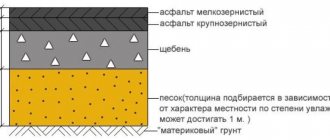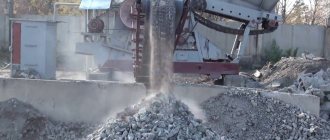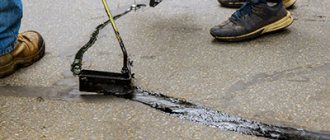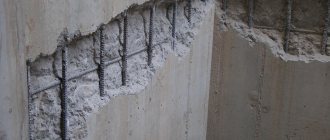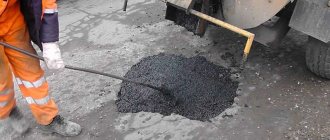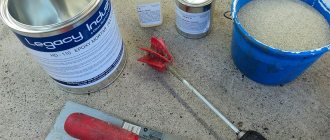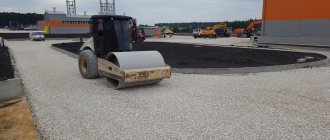- 1 Definition
- 2 What are the compositions?
- 3 Rules for laying coatings
- 4 Preparatory work
- 5 Making asphalt at home 5.1 Classic method
- 5.2 Application of old coating
- 5.3 Method of working with cold asphalt
When the construction of a personal home is completed, the stage of registration of a personal plot begins. Decorating flower beds, flower beds, sidewalks, planting various plants - this is just a small list of necessary operations that a person has to do. Many homeowners have a personal vehicle. That is why having a high-quality driveway to your home is simply necessary. Few people decide to carry out asphalt concrete pavement themselves. However, in this article we will look at all the subtleties and nuances of this process.
Definition
Asphalt is made from a special mixture. This solution is used everywhere. It is used to build highways, squares, streets and even garden paths. However, there are certain standards for asphalt concrete pavement. All this is prescribed in special GOST standards. The content of the asphalt concrete mixture is also indicated there. For more than a century, this pit composition has remained without any changes:
- The most important thing is the mandatory presence of bituminous material as a binder component.
- The presence, in a certain dosage, of quarry sand, as well as mineral additives, is required.
- The last necessary component is a synthetically created additive.
When the use of asphalt concrete pavement first began, the bituminous material used was of natural origin. However, due to its limited amount in nature, a need arose for a synthetic analogue. This analogue is produced from oil industry waste. It is still used now.
Sand is used mined in quarries, but crushed stone, slag and crushed rock are used as mineral additives. Additives are used to improve certain characteristics of the coating, such as frost resistance, viscosity index and much more.
Return to contents
Device technology
Preparation and calculations
The process involves organizing a specific location for coverage, namely:
The height of each layer of the road must be calculated so that the entire road surface does not rise above the sidewalk and does not end up below it.
- Marking. Calculation of the width of the gravel layer and parameters of the asphalt concrete pavement layers.
- Determination of height. A trench is dug according to the parameters of a certain calculation regarding a specific case. Typically, the height of roads and sidewalks is kept at the same level, so the asphalt “pie” is leveled over the entire intended area.
- Alignment. After thorough technical cleaning, the trench is compacted using special equipment. If the operation includes curbs, they are installed at this stage.
Preparing the mixture
The designs of road pavements with asphalt concrete pavement may differ in composition. Such an exchange depends on the operating conditions of the material. In order for it to fulfill its purpose and comply with the standards, technologists carry out precise calculations and a map for selecting the composition to be used. The delivery certificate for the asphalt concrete mixture contains all the data obtained in the experimental operations, which includes the following:
The future operating conditions of the material affect its design.
- power and shock loads;
- external influence factors;
- specific conditions;
- strength and stability coefficient;
- climatic and atmospheric influences;
- indicators of terms for operation.
Distribution and compaction
The road surface on which the asphalt concrete pavement is to be laid must be compacted and have a perfectly flat surface. If in fact there are large gaps, leveling is carried out with one layer of coarse-grained mixture. The next stage is clearing the area of construction debris. After cleaning, the surface is treated with a thin layer of bitumen or an emulsion based on it. This procedure is carried out immediately 5-7 hours before the main asphalt laying. If we are talking about laying roads from asphalt concrete, which will be carried out no later than two days after leveling, there is no need to prime with a binder; it is included in the ready-made composition of the material.
At temperatures below zero, cold-type material is used for such work.
Asphalting is carried out in good weather, excluding precipitation such as rain and fog. The required air temperature depends on the type of asphalt concrete pavement: hot type at +5-10, cold - not lower than - 11 degrees Celsius. The layer of asphalt to be laid must have a thickness of at least 4.5 cm. Immediately after the road mixture is distributed, the laying is compacted using smooth drum, pneumatic or combined rollers.
What are the compositions?
Asphalting the area.
The market for manufactured coating materials is incredibly large. The types depend on the dosage of internal components and the type of additives. Professionals divide asphalt into the following types:
- For designing sidewalks, paths in the garden or courtyard. The base is sand mixtures.
- Finely ground mortars are used to pave city streets with light traffic, and they are also used for pothole repairs.
- Coarse asphalt is used to create the underlying layer. It is performed when using a multilayer processing method.
- Coatings made using bitumen and polymers are used in the construction of roads on bridges or large road junctions. Their distinguishing feature is considered to be higher durability and strength.
- Concrete, which contains crushed stone and construction mastic, is recognized as the most durable. Therefore, it is used to create asphalt concrete pavement on highways.
- Treatment of sports surfaces is carried out using concrete with bitumen-rubber components.
Return to contents
What is asphalt pavement pie
Strength and reliability depend on the quality of the asphalt road pie. An asphalt laying pie is a multi-layer base that consists of soil, sand and crushed stone layers. The thickness of each part of the asphalt road pie is calculated according to GOST and SNiP. Each layer is rammed and compacted.
The base guarantees the safety and strength of the route. Without a multi-layer base, asphalt will quickly crumble under heavy vehicles. The multilayer fabric evenly distributes the load over the entire surface.
Preparatory work
Construction of asphalt concrete pavement.
No matter what you do, you need to start by marking the territory. You need to decide exactly where the path will be located. It is also worth pre-installing drainage and drainage systems. Underground structures must be installed by the time the paths are covered.
During the preparatory operations, it will be important to make a decision about the asphalt concrete pavement, or, more precisely, about the materials for this coating. If pedestrian asphalt concrete pavements will be periodically used by motorists, then it is advisable to make a special gravel-crushed stone layer about 15 centimeters wide. The width of the surface layer of the coating will then range from 5 to 6 centimeters. For asphalt concrete pavements at gas stations, the width of the gravel layer is about 30 centimeters. The top layer of asphalt is laid in about a couple of layers.
When the path is marked, they begin to dig a trench under it. Often, the street surface and sidewalk areas are made at the same height, which is why the soil is removed across the entire width of the asphalt “pie.” The technology for installing high-speed routes is slightly different, but we will not discuss it.
Once the surface soil has been removed, the trench must be thoroughly compacted. This can be done using a roller. If curbs are provided, it is better to install them at this stage. The asphalt “pie” will be in a kind of formwork made from curbs. You can also make special ditches to drain water.
Further, the technology provides for asphalt concrete processes to form a crushed stone layer. For sidewalks, one ball is enough; if more powerful concrete is needed, then crushed stone is laid in several layers. The lower layer is a special drainage for groundwater. It is made from coarse crushed stone. The further layer will help distribute the pressure on the asphalt surface.
The final treatment of the backfill layers involves the formation of the last crushed stone layer of fine fraction. It will help make the entire pillow durable and monolithic. Each layer must be carefully compacted. If asphalt concrete pavements will be subject to severe pressure, then compact the crushed stone using a roller at least 6 times. During this operation, crushed stone must be additionally treated with water.
Return to contents
The use of geosynthetic materials for the construction of road pie
Along with traditionally used materials (crushed stone and sand), the program of technical specifications for the construction of a road pie includes the use of geosynthetics. Builders actively use innovative technologies and a range of high-quality geosynthetic materials, which provides customers with reliable asphalt or concrete coverings, overpasses and bridges. By increasing the wear resistance of the road pavement, the cost of road construction and the frequency of repairs are reduced.
Making asphalt at home
Preparing a mixture of concrete and asphalt is considered a complex process. However, there are a huge number of people ready to experiment. Such mixtures cannot be used for highways, but they are quite suitable for decorating asphalt at home.
Return to contents
Classic method
The additive makes cold asphalt more durable.
To make asphalt concrete pavement, you need sand, bituminous material (resin), and small crushed stone. Inventory you will need is a large container and a bucket. It is better to use a fire to cook the asphalt mixture; it is cheaper and safer.
Place sand and crushed stone additives in a 2 to 1 ratio and mix thoroughly. Add water and place the container on the fire. At the same time, we begin preparing the bitumen additive. Here you will need a metal bucket. It is necessary to melt the bitumen resin in a bucket over the fire. When the mixture additives in both containers have boiled, they can be mixed. After mixing, return the container to the heat and continue to boil until the water has completely boiled away. Surface finishing with concrete is carried out while the solution is hot.
Return to contents
Application of old coating
This method is used both to create a new surface and can be used to repair asphalt concrete pavements. For the most part, the work process is similar to the previous method, but there are some nuances.
- The old coating is removed using sledgehammers; the crushed stone cushion is not dismantled.
- The coating must be crushed into small fractions.
- The crushed coating is poured with water and melted in a container over a fire.
- After this, surface work continues according to the previous method.
Return to contents
Method of working with cold asphalt
Suitable if there is a need not to carry out pothole repairs, but to decorate a large area. This method gained its popularity relatively recently, about 5-10 years ago. The operating principle is similar to cold welding. One of the main components is special bitumen, which allows the entire necessary process to be carried out even at subzero temperatures.
Its disadvantage is considered to be its rather high cost. But in cases where it is not possible to install using classical methods, cold asphalt is an excellent alternative.
Return to contents
Geoflax geogrid for road cake
The use of geogrid makes it possible to improve operational characteristics and reduce construction costs by 45%. During operation, the geogrid shows high resistance to the deformation process.
In the modern environment, it is necessary to strive to increase the service life of materials used in the construction of road surfaces. We are well aware that the durability of a road pie depends on compliance with all industry demands, carrying out work in accordance with customer requirements, and existing standards.
Recommended materials:
Flat geogridGeogrid volumetric Geotextiles
Submit your application
With GeoSM materials, they achieve a significant acceleration of work on constructing a road surface pie. Professionals recommend using GeoSM geosynthetics.
Influence of materials on coating quality
The thickness of the laying depends on the purpose of using the asphalt concrete pavement.
The main nuance in operations related to laying asphalt pavements is the correct and accurate choice of materials. To avoid having to constantly perform pothole repairs, you need to treat this issue carefully. Otherwise, sealing cracks in asphalt concrete pavement will become an eternal problem. It is important to complete all layers using an asphalt paver at the same time. This has a big impact on the quality of the track.
Despite the fact that classic concrete has good strength, this indicator can be improved. The most popular method is to use special types of asphalt mastic. These mastics contain bitumen emulsions and rubber polymers. Conventional bitumen mastic is used only in a hot state, but the emulsion is used in a cooled state. Mastics help to better seal cracks on the surface of the coating. This prevents water from seeping inside and prevents the fabric from destruction.
The period of operation of the roadway depends not only on the condition of the materials, but also on the design of the road surface. The same type of asphalt mixture can behave differently on different types of substrate. On paths and routes located on a cement-concrete base, cracks appear over time. This happens due to a discrepancy between the thermophysical characteristics. A crushed stone base does not pose the risk of such complications, but they can cause a certain shrinkage of the entire path.
Return to contents
Asphalt laying technology according to GOST
The characteristics of the road and technical requirements for the construction of new routes and the implementation of repairs during the operation of the road surface are enshrined in GOST. According to the standard, the stages of asphalt laying technology include:
- a set of preparatory measures;
- preparation of the roadbed;
- carrying out the necessary communications and engineering systems;
- construction of the foundations of the future road: covering with sand, crushed stone or a reinforced concrete base;
- paving or covering the surface with asphalt chips;
- improvement of the territory.
The asphalt paving process can be carried out in 2 ways:
- Laying cold asphalt - in this case, large-scale compaction and compaction measures are not required. Using this technology, you can repair roads or improve crushed stone roads, including on days with negative air temperatures (up to -10 degrees).
- The technology for laying hot asphalt involves preparing a special mixture of bitumen and fine gravel, which is laid exclusively on warm days without precipitation. The quality of the road surface is determined by the temperature of the finished mixture (from 100 to 160 degrees).
Asphalt repair
As standard, for road repairs, an asphalt concrete mixture of type B-2 is used. This material is used for laying the top layer of road surfaces, and also used for pothole, current, surface treatment and major repair of damage. For reconstruction, a cold or hot mixture of material is used. The repair technology provides two options: the asphalt casting method, which is carried out using technology, or the jet-injection method, which is carried out mechanically.
